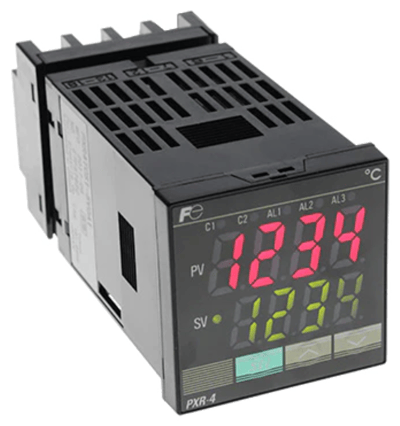PXR4 Socket Series Temperature Controller
Brand: Fuji Electric Co, LtdWith front dimensions of 48 × 48 mm, this socket type temperature controller enables On-Off control, PID control or 8-step ramp/soak function, using thermocouple, resistance bulb or DC 1-5 V signal as input.
Though small-sized, it can be equipped with a variety of functions.
Features- PID with auto-tuning, PID self-tuning and fuzzy control are installed as standard
- Front side waterproof specification in conformity with NEMA 4X (standard)
- Two alarms are equipped, and 8-step ramp/soak function can be installed as an option
Displaying prices & availability for Ohio, United States in USD. Change location.
Models matching criteria: 1
- Front Panel Size - 1/16 DIN (48 x 48 mm)
- Input Signal - Thermocouple (° C)
- Output 1 - Relay Contact Output
- Alarm Option - Without Alarm Option
- Power Supply - 100-240 Vac, 50/60 Hz
Call for Pricing & Availablility
Does not ship to OH, United States
Specifications
Accuracy
- B Thermocouple: ± 5 % of Measurement Range ± 1-Digit ± 1° C (± 1.8° F) at 0° to 400° C (32° to 752° F)
- Input Value Correction: ± 10 % of Measuring Range
- Reference Junction Compensation: ± 1° C (± 1.8° F) at 23° C (73.4° F)
- R Thermocouple: ± 1.0 % of Measurement Range ± 1-Digit ± 1° C (± 1.8° F) at 0° to 500° C (32° to 932° F)
- Set Value Correction: ± 50 % of Measuring Range
- Thermocouple: ± 0.5 % of Measurement Range ± 1-Digit ± 1° C (± 1.8° F)
- Voltage/Current: ± 0.5 % of Measurement Range ± 1-Digit
Ambient Temperature Range
- -10° to 50° C (14° to 122° F)
Consumption
- Power Consumption: 10 VA or Less (220 V & 24 Vac/dc)
- Power Consumption: 8 VA (100 V)
Control Functions Characteristics
- Self-Tuning, Fuzzy, Auto-Tuning: PID Control
Cover Type
- Terminal Cover
Current
- Minimum Switching Current: 100 mA (5 Vdc)
- SSR/SSC Drive: Max.
Delay Time
- Alarm ON-Delay: 0 to 9,999 seconds Set 1 second steps
Display
- Large 4-Digit LED
Electrical Rating
- Relay Contact: 3 A at 220 Vac / 30 Vdc - Resistive Load
Enclosure, Body Material
- Plastic (Non-Combustible)
Environmental Protection
- Faceplate: IP66
- Faceplate: NEMA 4X
- Rear Case: IEC IP20
Filter
- Input Filter: 0 to 900 seconds Settable in 0.5 second steps
Humidity
- Operating/Storage Ambient Humidity: less than 90 % RH, Non-Condensing
Input
- 4-20 mA
- Remote Set Point: 1-5 Vdc, 1-Point
Input Impedance
- Current: 250 ohms (External Resistor)
- Thermocouple: 1 MΩ or more
- Voltage: 450 kΩ or more
Insulation Resistance
- 20 MΩ or more at 500 Vdc
Load Resistance
- Output (4-20 mA DC): 600 ohms or Less
Measuring Range
- -150° to 1,800° C (-238° to 2,912° F)
Mounting
- DIN Rail Mounting
- Panel Flush Mounting
Operation
- Electrical Life (Relay Contact/Digital Output): 100,000 Operations Min.
- Mechanical Life: 10 Million Operations (No Load)
Output
- 4-20 mA DC
- Process Alarm: 1 A at 220 Vac / 30 Vdc, Max.
- SSR/SSC Drive (OFF): 0.5 Vdc
- SSR/SSC Drive (ON): 17-25 Vdc
Output Noise
- Noise Reduction Ratio (Common Mode): 140 dBor more (50/60 Hz)
- Noise Reduction Ratio (Normal Mode): 50 dB or more (50/60 Hz)
Power Supply
- 100-240 Vac (-15 %, 10 %), 50/60 Hz
- 24 Vac/dc (± 10 %), 50/60 Hz
Resistance
- Allowable Signal Source Resistance (Thermocouple): 100 ohms or Less
- Allowable Signal Source Resistance (Voltage): 1 Kiloohm or Less
- Allowable Wiring Resistance (Resistance Bulb): 10 ohms or Less Per Wire
RTD Type
- Pt100
Sensor, Probe Type
- B Thermocouple
- E Thermocouple
- J Thermocouple
- K Thermocouple
- N Thermocouple
- R Thermocouple
- S Thermocouple
- T Thermocouple
Storage Temperature
- -20° to 60° C (-4° to 140° F)
Supply Voltage
- Dielectric Strength (Others): 500 Vac/minute
- Dielectric Strength (Power Supply-Ground, Power Supply-Others, Ground-Relay Output, Ground-Alarm Output): 1,500 Vac/minute
Switch Type
- SPDT
- SPST
Termination
- External Terminal: 8-Pins or 11-Pins Terminals (Socket is Required for Wiring Separately)
